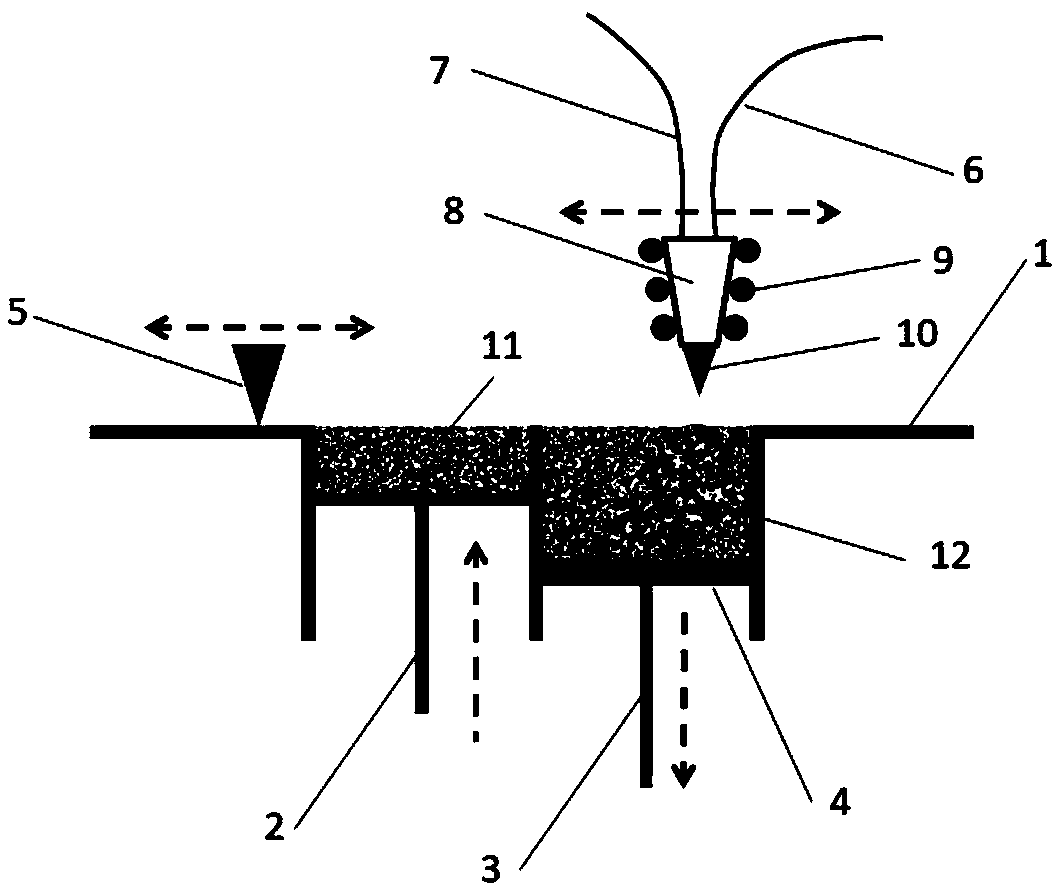Ceramic material additive manufacturing method
A technology for additive manufacturing and ceramic materials, applied in the direction of additive processing, etc., can solve the problems of inability to achieve additive manufacturing of silicon carbide ceramic powder, hinder the solid-phase crystallization reaction of ceramic particles, weaken the strength of materials, etc., and achieve one-time molding. , wide applicability, the effect of improving the density
- Summary
- Abstract
- Description
- Claims
- Application Information
AI Technical Summary
Problems solved by technology
Method used
Image
Examples
Embodiment 1
[0053] Embodiment 1: Additive manufacturing method of alumina ceramics
[0054] 1) Model design and layering: Design the part model to be printed, use computer software to layer, calculate the area to be bonded for each layer, and generate a printer control program including the adhesive injection path.
[0055] 2) Preparation of alumina ceramic powder raw material: select alumina ceramic powder with a particle diameter of 60 nm as the raw material, and put it into the feed tray of the ceramic powder bonded printer.
[0056] 3) The calculated ratio of the adhesive: use bisphenol F glycidyl ether (BFDGE) as the epoxy resin monomer, which contains two epoxy functional groups on each molecule; use diethyltoluenediamine (DETDA) As a hardener, it contains two amine functional groups per molecule. The amine functional groups on each hardener are selected to correspond to 2.2 epoxy functional groups on the epoxy resin monomer, so the molar ratio of BFDGE and DETDA can be determined ...
Embodiment 2
[0061] Embodiment 2: Additive manufacturing method of silicon carbide ceramics
[0062] 1) model design and stratification: same as embodiment 1;
[0063] 2) Preparation of silicon carbide ceramic powder raw materials: mix β-SiC powder with a particle size of 100nm and trace C and B powders in a ratio of 100:3:1 as raw materials;
[0064] 3) The calculation ratio of the adhesive: use a mixture of triepoxyphenyl p-aminophenol (TGAP) and tetraepoxyphenyl diaminodiphenylmethane (TGDDM) as the epoxy resin monomer, which corresponds to each molecule Contains three or four epoxy functional groups; Diethyltoluenediamine (DETDA) is used as a hardener, which contains two amine functional groups per molecule. The amine functional groups on each hardener are selected to correspond to the epoxy functional groups on the two epoxy resin monomers, so the molar ratio of TGAP, TGDDM and DETDA can be determined to be 2:1:5.
[0065] 4) Adjust the delivery speed of the hardener delivery pipe a...
Embodiment 3
[0069] Embodiment 3: Additive manufacturing method of ferrite ceramics
[0070] 1) For the model design and layering, the calculation ratio of the adhesive, and the printing process, please refer to Example 1 or Example 2.
[0071] 2) Preparation of ferrite ceramic powder raw material: Manganese-zinc ferrite powder with brand PC40 was used as raw material.
[0072] 3) According to the aforementioned method, after the ceramic body is printed and cleaned, the ceramic body is placed in a sintering furnace, heated to 140°C, and kept for 3 hours to remove the moisture contained in it; then heated to 600°C in an air environment ℃, keep warm for 6 hours to remove the binder components; finally, heat to 1200 ℃ in an inert gas environment, keep warm for 5 hours, so that the manganese zinc ferrite powder is sintered into finished solid ceramic parts.
PUM
| Property | Measurement | Unit |
|---|---|---|
| diameter | aaaaa | aaaaa |
| diameter | aaaaa | aaaaa |
| particle diameter | aaaaa | aaaaa |
Abstract
Description
Claims
Application Information
 Login to View More
Login to View More - R&D
- Intellectual Property
- Life Sciences
- Materials
- Tech Scout
- Unparalleled Data Quality
- Higher Quality Content
- 60% Fewer Hallucinations
Browse by: Latest US Patents, China's latest patents, Technical Efficacy Thesaurus, Application Domain, Technology Topic, Popular Technical Reports.
© 2025 PatSnap. All rights reserved.Legal|Privacy policy|Modern Slavery Act Transparency Statement|Sitemap|About US| Contact US: help@patsnap.com


